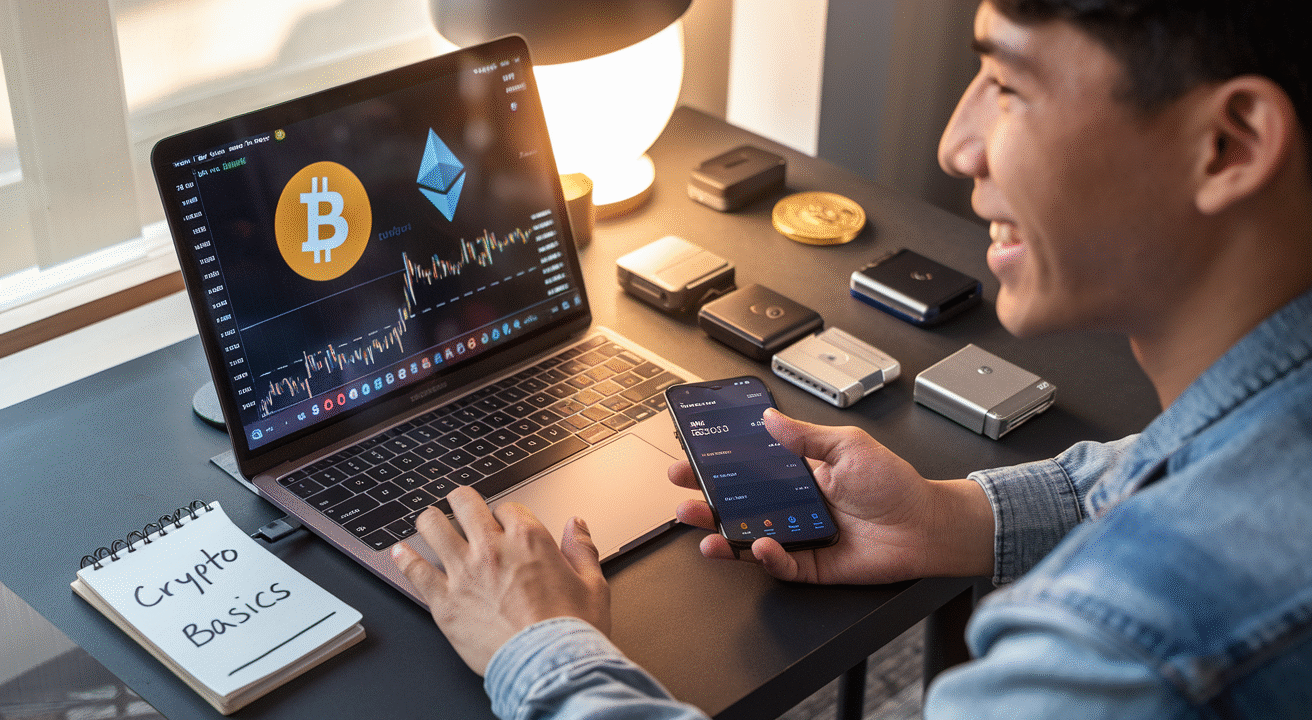
Ever stared at crypto charts feeling like you’re trying to decipher alien hieroglyphics? You’re not alone. A whopping 84% of would-be investors never make their first crypto purchase because they’re overwhelmed by the jargon and technical mumbo-jumbo.
But here’s the thing—investing in cryptocurrency doesn’t have to be complicated. Not even a little bit.
In this beginner’s guide to cryptocurrency investing, I’m going to break everything down into bite-sized, actionable steps that your non-tech-savvy aunt could follow.
No complex terminology. No pretending you need a finance degree. Just clear instructions that work.
And the best part? The strategy I’m about to share helped my complete-beginner students turn $500 into consistent passive income within months. Curious how they did it without watching charts all day?
Understanding Cryptocurrency Basics
What Is Cryptocurrency and How Does It Work
Imagine digital money that doesn’t need a bank to work. That’s crypto in a nutshell.
Cryptocurrency is digital or virtual money secured by cryptography, making it nearly impossible to counterfeit. Unlike traditional currencies issued by governments, cryptocurrencies operate on decentralized networks using blockchain technology.
The blockchain is basically a super fancy digital ledger that records all transactions across a network of computers. When you send Bitcoin to your friend, that transaction gets verified by miners (people with powerful computers solving complex math problems), then added to a “block” and linked to previous blocks – creating a chain. Hence, blockchain.
What makes crypto different from your regular bank account? Nobody’s in charge. There’s no central authority like a bank or government controlling it. It’s all run by the community of users.
Here’s the cool part – most cryptocurrencies have a finite supply. Bitcoin, for example, will only ever have 21 million coins. Compare that to regular money that governments can print whenever they want, potentially causing inflation.
Key Terminology Every Beginner Should Know
Diving into crypto without knowing the lingo is like trying to order coffee in a foreign language – confusing and potentially expensive.
Wallet: Not the leather thing in your pocket. A crypto wallet is software that stores your private keys, allowing you to access and manage your digital assets. Hot wallets are connected to the internet, while cold wallets are offline storage devices (much safer).
Private Key: Think of this as your crypto password. It’s a string of random characters that proves ownership of your crypto. Lose this, and you lose your crypto. Forever.
Public Key: The address others use to send you crypto. It’s like your username – public and shareable.
Mining: The process of validating transactions and adding them to the blockchain. Miners get rewarded with new coins for their work.
DeFi: Short for Decentralized Finance. It’s a whole ecosystem of financial applications built on blockchain networks.
Smart Contract: Self-executing contracts with the terms directly written into code. They automatically execute when conditions are met.
Gas Fees: Transaction costs paid to miners/validators for processing your transaction on the network.
HODL: Crypto slang for holding onto your coins rather than selling, regardless of market conditions. Originally a typo for “hold” that became legendary.
Major Cryptocurrencies Beyond Bitcoin
Bitcoin might be the rockstar of crypto, but there’s a whole band playing alongside it.
Ethereum (ETH): More than just money, Ethereum is a platform for building decentralized applications. Its native currency, Ether, fuels the network. With the switch to Ethereum 2.0, it’s now significantly more energy-efficient and scalable.
Solana (SOL): Known for blazing-fast transaction speeds and low fees, Solana has become a serious contender in the DeFi and NFT spaces. It can process up to 65,000 transactions per second – compare that to Bitcoin’s 7.
Cardano (ADA): Developed by Ethereum co-founder Charles Hoskinson, Cardano focuses on sustainability, scalability, and transparency. It uses a peer-reviewed approach to development.
Polkadot (DOT): Created to enable different blockchains to transfer messages and value in a trust-free fashion. Think of it as an internet of blockchains.
Ripple (XRP): Designed for payment providers and financial institutions to process global payments quickly and cheaply.
Avalanche (AVAX): A layer-1 blockchain that’s incredibly fast, low cost, and eco-friendly. It’s become a major player in the smart contract space.
Why Invest in Crypto in 2025
The crypto landscape in 2025 looks dramatically different than even a few years ago.
First off, institutional adoption has exploded. Major banks, investment firms, and corporations now hold crypto on their balance sheets. What was once considered fringe is now mainstream.
Regulation has matured significantly. The wild west days are largely behind us, with clearer frameworks providing more certainty for investors. This hasn’t stifled innovation – it’s actually encouraged more traditional investors to enter the space.
The technology has evolved too. Scalability issues that plagued early cryptocurrencies have been largely solved, with networks processing thousands of transactions per second at minimal cost.
Real-world use cases have expanded beyond speculation. Cryptocurrencies are being used for remittances, providing financial services to the unbanked, tokenizing real estate, and revolutionizing supply chain management.
Looking at performance, crypto has emerged as a legitimate asset class. While still volatile, many cryptocurrencies have outperformed traditional investments over the past five years.
The integration of crypto with emerging technologies like AI, IoT, and virtual reality is creating entirely new economic models and opportunities that simply didn’t exist before.
In short, crypto in 2025 has moved from “if” to “how” in terms of its place in the financial ecosystem.
Setting Up Your Crypto Investment Foundation
Creating a Secure Digital Wallet
Getting started with crypto means you need a safe place to store your digital assets. Think of a wallet as your personal crypto bank account. You’ve got two main options:
Hot wallets connect to the internet, making them convenient but slightly less secure. Examples include MetaMask, Trust Wallet, and Coinbase Wallet.
Cold wallets stay offline, making them much harder to hack. Popular hardware options include Ledger and Trezor, which look like small USB drives.
For beginners, I recommend starting with a reputable hot wallet for small amounts, then upgrading to a cold wallet once you’ve invested more than a few hundred dollars.
Choosing the Right Cryptocurrency Exchange
Not all crypto exchanges are created equal. Some key factors to consider:
- Fees: They can eat into your profits faster than you’d think
- Available coins: Make sure they offer what you want to buy
- User interface: If you can’t figure out how to use it, it’s useless
- Liquidity: Higher trading volume means you can buy and sell more easily
For newcomers, Coinbase, Binance, and Kraken offer user-friendly interfaces with decent coin selection. If you’re in the US, make sure to use exchanges that comply with regulations (like Coinbase or Gemini).
Setting Up Strong Security Measures
Crypto security isn’t optional—it’s absolutely essential. Here’s what you need:
-
Two-factor authentication (2FA): Always enable this. Google Authenticator or Authy are better than SMS verification.
-
Unique passwords: Use a password manager to create and store complex passwords.
-
Phishing awareness: Never click suspicious links or share your private keys.
-
Backup your seed phrase: Those 12-24 words are your only recovery option if something goes wrong. Write them down and store them somewhere safe—not on your computer or phone.
Verifying Your Identity (KYC Requirements)
Most legitimate exchanges require KYC (Know Your Customer) verification. This process typically includes:
- Uploading a government-issued ID
- Taking a selfie
- Providing proof of address
- Answering basic questions about your income and investment goals
This might feel invasive, but it’s actually a good sign—it means the exchange is following regulations designed to prevent money laundering and fraud.
The verification process usually takes anywhere from a few minutes to a few days, depending on the platform and verification queue.
Funding Your Account Safely
Once your account is set up, you’ll need to add funds. You’ve got options:
- Bank transfers: Usually the cheapest method but can take 3-5 business days
- Debit/credit cards: Instant but come with higher fees (often 3-5%)
- PayPal/other payment apps: Convenient but typically expensive
Start small until you’re comfortable with the process. Many beginners make their first purchase around $50-100 to get familiar with how everything works.
When transferring funds, always double-check the details and send a test transaction first if you’re moving large amounts.
Developing Your First Investment Strategy
Determining Your Risk Tolerance
Look, jumping into crypto without knowing your risk tolerance is like swimming in the ocean without checking for sharks. It’s all fun until something bites.
Your risk tolerance boils down to: how much money can you lose without having a meltdown?
Some people can watch their investment drop 50% and still sleep like a baby. Others panic when they’re down 5%. Which one are you?
Ask yourself these questions:
- Would losing all your crypto investment affect your daily life?
- Do price swings make your stomach turn?
- Are you investing money you might need next month?
If you answered “yes” to any of these, you might want to dial back your exposure. Remember, Bitcoin once dropped from $20,000 to $3,000. Ethereum lost over 90% of its value in 2018. Could you handle that?
How Much Should You Invest as a Beginner
The golden rule in crypto: Never invest more than you can afford to lose. Seriously.
I’m not saying you WILL lose it all, but you COULD. That’s the reality.
For beginners, start with 1-5% of your investment portfolio. That’s it.
Think about it this way: $100 in crypto won’t change your life if it moons, but it also won’t ruin you if it crashes to zero.
As you learn more and build confidence, you can gradually increase your position. But rushing in with your life savings? That’s how horror stories begin.
Dollar-Cost Averaging vs. Lump Sum Investing
There are two main ways to buy crypto, and they both have their fans:
Dollar-Cost Averaging (DCA): You buy a fixed amount at regular intervals, regardless of price.
Lump Sum: You throw all your money in at once and pray to the crypto gods.
Here’s how they stack up:
| Strategy | Pros | Cons |
|---|---|---|
| DCA | Reduces impact of volatility, Less emotional stress, Works well in bear markets | Potentially lower returns in bull markets, Requires discipline |
| Lump Sum | Better returns in long-term upward markets, One-and-done approach | Higher risk if you buy at a peak, Can cause major anxiety |
For beginners, DCA is usually smarter. Buying $50 of Bitcoin every week feels way less stressful than dropping $2,600 all at once.
Long-Term HODLing vs. Active Trading
HODL (hold on for dear life) or trade? This is where many beginners get wrecked.
Trading looks sexy. The charts, the candles, the idea of buying low and selling high. But here’s the brutal truth: most traders lose money. Even professional traders struggle to beat simple buy-and-hold strategies.
HODLing means buying and holding for years, ignoring the day-to-day noise. Trading means trying to time the market, which is incredibly hard.
Consider this:
- HODLing Bitcoin for any 4-year period has never resulted in a loss (so far)
- Studies show 95% of day traders lose money
If you’re just starting out, HODLing is probably your best bet. Trading requires technical knowledge, emotional control, and lots of time. Plus, in many countries, each trade is a taxable event – making your tax situation a nightmare.
Start simple. Get comfortable. Then decide if you want to dive deeper.
Making Your First Cryptocurrency Purchase
A. Step-by-Step Guide to Buying Bitcoin
So you’ve decided to jump into crypto. Awesome! Buying your first Bitcoin doesn’t have to be complicated. Here’s how to do it:
-
Choose a reputable exchange – Coinbase, Binance, and Kraken are popular options for beginners. They’re like the Amazon of crypto.
-
Create and verify your account – You’ll need to provide some ID and proof of address. Yeah, it’s annoying, but it’s to prevent fraud and money laundering.
-
Connect your payment method – Most exchanges accept bank transfers, debit cards, and sometimes credit cards. Bank transfers usually have lower fees but take longer.
-
Place your order – Decide how much Bitcoin you want to buy. Don’t worry—you don’t need to buy a whole Bitcoin! You can start with as little as $10.
-
Confirm and complete – Double-check all details before hitting that buy button. Once confirmed, congratulations! You officially own some Bitcoin.
B. How to Purchase Altcoins
Want something beyond Bitcoin? Altcoins (alternative cryptocurrencies) might be what you’re looking for:
-
Buy Bitcoin or Ethereum first – Most altcoins can’t be purchased directly with dollars. You’ll typically need BTC or ETH first.
-
Find an exchange that lists your desired altcoin – Not all exchanges list every coin. Binance has the widest selection for beginners.
-
Transfer your BTC/ETH to that exchange – If you already bought Bitcoin on another platform, you’ll need to send it to your new exchange.
-
Make the trade – Look for trading pairs like ADA/BTC or DOT/ETH, which let you trade Bitcoin or Ethereum for these altcoins.
-
Consider a wallet – For larger investments or long-term holding, move your altcoins to a personal wallet rather than leaving them on the exchange.
C. Reading Basic Price Charts
Charts might look intimidating at first, but you only need to understand a few basics:
Candlestick charts show you four crucial pieces of information:
- Opening price (where the candle starts)
- Closing price (where it ends)
- Highest price during that period (the wick on top)
- Lowest price during that period (the wick on bottom)
Green candles mean the price went up during that period. Red means it went down.
Time frames matter too. Switching between 1-hour, 4-hour, daily, and weekly views gives you different perspectives on price movement.
Volume bars at the bottom of most charts show how much trading activity is happening. Higher volume usually means stronger price movements.
D. Setting Up Price Alerts
Nobody has time to watch crypto prices 24/7. That’s where alerts come in:
-
Use exchange alerts – Most major exchanges let you set basic price alerts right in their app or website.
-
Try dedicated apps – CoinMarketCap, CoinGecko, and TradingView offer more advanced alert options.
-
Set meaningful thresholds – Don’t set alerts for every tiny price movement. Focus on significant support/resistance levels.
-
Consider percentage changes – Rather than absolute prices, alerts for “10% drop in 24 hours” can be more useful.
-
Use alerts as decision triggers – When you get an alert, have a plan. Is this a buying opportunity? Time to take profits? Just something to watch?
E. Executing Your First Trade
Trading is where the rubber meets the road in crypto. Here’s how to make your first move:
-
Decide on your trade type:
- Market order: buys/sells immediately at current market price
- Limit order: only executes when the price reaches your specified level
-
Start small – Your first trades should be learning experiences, not massive bets. Maybe $50-100 to get comfortable with the process.
-
Watch the order book – This shows pending buy and sell orders. Large “walls” can indicate strong support or resistance levels.
-
Be mindful of fees – They vary between exchanges and can eat into profits, especially for frequent traders.
-
Keep records – Track your trades manually or use portfolio apps. This helps with taxes and learning from your decisions.
Remember that your first few trades will probably feel weird and nerve-wracking. That’s completely normal! With practice, the process becomes second nature.
Managing Your Crypto Portfolio
Portfolio Tracking Tools for Beginners
Jumping into crypto can feel like trying to juggle while riding a unicycle. Trust me, keeping track of your coins across different exchanges and wallets isn’t exactly a walk in the park. But don’t sweat it—there are some awesome tools that make this way easier.
For beginners, I recommend starting with CoinMarketCap or CoinGecko. Both are free and let you manually input your holdings to watch how they perform. They’re basically like the training wheels of crypto tracking.
Ready for something more automated? FTX (formerly Blockfolio) connects directly to exchanges through APIs, updating your portfolio in real-time. No more midnight math sessions trying to figure out if you’re up or down!
If you’re spreading investments across multiple platforms, Delta or CoinTracker might be your new best friends. They sync with almost every major exchange and even track those coins sitting in cold storage.
Popular Tracking Tools:
| Tool | Best For | Cost |
|------|----------|------|
| CoinMarketCap | Basic tracking | Free |
| CoinGecko | Market research | Free |
| FTX | Real-time updates | Free/Premium |
| Delta | Multiple exchanges | Free/Premium |
| CoinTracker | Tax reporting | Free/Premium |
Balancing Your Crypto Assets
You wouldn’t put all your eggs in one basket, right? Same goes for crypto.
Smart investors follow what I call the crypto pyramid strategy:
- Base layer (60-70%): Bitcoin and Ethereum. These are your crypto blue chips—less explosive growth but way more stability.
- Middle layer (20-30%): Established altcoins with solid use cases. Think Solana, Cardano, or Polkadot.
- Top layer (5-10%): Higher-risk moonshots. Only play here with money you can laugh about losing.
Rebalancing is key. When that random altcoin suddenly pumps 300%, consider moving some profits down the pyramid. Your future self will thank you when the inevitable correction comes.
A typical rookie mistake? Chasing every hot new coin. FOMO is real, but spreading yourself too thin across 30+ cryptocurrencies makes tracking nearly impossible.
When to Hold and When to Sell
The million-dollar question in crypto isn’t just what to buy—it’s when to sell.
First, ditch the idea that you need to time the market perfectly. Nobody—and I mean nobody—consistently buys the bottom and sells the top.
Instead, consider these exit strategies:
- Set target prices. Decide in advance: “I’ll sell 25% when coin X hits $Y.”
- Use the 2x rule. When an investment doubles, pull out your initial stake. Now you’re playing with house money.
- Scale out gradually. Sell in increments (10% at a time) as prices rise, rather than trying to nail the exact peak.
The hardest part? Holding during downturns. During the last bear market, Bitcoin dropped over 80% from its high. Those who panicked and sold everything locked in losses. Those who held (and even bought more) during the blood bath? They’re the ones relaxing on beaches right now.
Remember: Time in the market beats timing the market. If you believe in the long-term potential of crypto, sometimes the best strategy is simply to do nothing.
Avoiding Common Beginner Mistakes
Recognizing Crypto Scams and Frauds
Look, the crypto world is like the Wild West sometimes. Scammers are everywhere, and they’re getting smarter every day.
The most common scam? Those “guaranteed return” promises. Anyone telling you they can double your Bitcoin in 24 hours is lying to your face. Period.
Then there’s the fake ICOs (Initial Coin Offerings) where developers create a fancy website, write an impressive-sounding whitepaper, and disappear with everyone’s money. In 2024 alone, investors lost over $2.8 billion to these schemes.
Watch out for these red flags:
- Promises of unrealistic returns (nothing is guaranteed in crypto)
- Pressure to “act now” or “limited time offers”
- Projects with anonymous teams or sketchy backgrounds
- No clear use case for the token
Always DYOR (Do Your Own Research). Check the team on LinkedIn, read the whitepaper, and for heaven’s sake, Google the project name + “scam” before investing a dime.
Emotional Trading Pitfalls
Trading based on emotions is financial suicide.
FOMO (Fear Of Missing Out) makes you buy high when everyone’s celebrating. FUD (Fear, Uncertainty, Doubt) makes you panic sell at the bottom. Both are paths to losing money.
I’ve been there. In 2023, I panic-sold Ethereum at $1,800 during a market dip. Three months later, it was worth $3,600. Painful lesson.
Here’s how to keep emotions in check:
- Set price targets before buying
- Use stop-loss orders
- Stick to your investment plan, even when Reddit is screaming about the next moon shot
- Never invest more than you can afford to lose
The pros call it “having conviction.” I call it not looking at your portfolio every five minutes.
Tax Implications You Can’t Ignore
The tax man always finds you, even in crypto.
In most countries, each crypto transaction is a taxable event. That means:
- Selling crypto for cash? Taxable.
- Trading Bitcoin for Ethereum? Taxable.
- Buying a coffee with Bitcoin? Yep, taxable.
The IRS and other tax agencies are cracking down hard. In 2024, the IRS sent over 50,000 compliance letters to crypto holders.
Keep meticulous records of:
- Purchase dates and prices
- Sale dates and prices
- Fees paid on transactions
- Mining or staking income
Tax tracking apps like CoinTracker or Koinly can save your bacon when tax season rolls around. Worth every penny.
Unrealistic Return Expectations
The days of turning $100 into $1 million overnight are mostly gone.
Yes, some cryptos still see massive gains, but they’re usually high-risk projects with equal chances of going to zero.
Bitcoin’s early investors saw 1,000,000% returns, but that was when crypto was brand new. The market has matured.
Realistic annual returns might look more like:
- Blue-chip cryptos (Bitcoin, Ethereum): 30-100%
- Mid-cap altcoins: 100-300%
- Small speculative projects: Could be 1000%+ or -100%
Compare this to the stock market’s average 7-10% annual return, and crypto still looks attractive. But expecting to retire next month on your $500 investment? You’re setting yourself up for disappointment.
Start with reasonable goals, celebrate small wins, and think in years, not days.
Advancing Your Crypto Knowledge
Reliable Resources for Ongoing Education
The crypto world moves at lightning speed. What’s hot today might be obsolete tomorrow. That’s why continuous learning isn’t just nice—it’s necessary.
Start with established educational platforms like Coinbase Learn, Binance Academy, or CoinMarketCap Alexandria. These sites break down complex concepts without the hype.
For deeper dives, check out these gems:
- Crypto podcasts: “Unchained” with Laura Shin or “What Bitcoin Did” offer expert interviews and analysis you can absorb during your commute
- YouTube channels: Coin Bureau and Benjamin Cowen provide technical analysis without the moonboy predictions
- Books: “The Bitcoin Standard” by Saifedean Ammous or “Cryptoassets” by Chris Burniske give you the foundation that flashy TikTok videos never will
Just watch out for the “experts” with lambos in their thumbnails. If someone’s promising 100x gains overnight, your BS detector should be blaring.
Joining Crypto Communities
Flying solo in crypto is like navigating a maze blindfolded. You need others.
Reddit communities like r/CryptoCurrency offer diverse perspectives, though you’ll need to filter through the noise. Discord and Telegram groups for specific projects give you direct access to developers and fellow investors.
But here’s the real talk—these communities can be echo chambers. The same folks cheering “HODL!” during a bull run might panic-sell at the first price drop.
Create your circle wisely:
- Follow thoughtful critics who challenge your assumptions
- Engage with long-term investors who’ve weathered multiple market cycles
- Look for communities that welcome beginner questions without mockery
- Pay attention to developer communities—they’re often discussing what matters for long-term adoption
The quality of your crypto journey often matches the quality of your community.
Understanding Market Cycles
Crypto markets swing wildly—but these swings follow patterns.
Bitcoin historically moves through four-year cycles, influenced by its halving events (when mining rewards are cut in half). After each halving, we typically see:
- Accumulation phase (smart money buying)
- Early uptrend (institutional interest grows)
- Bull market mania (your uncle starts asking about NFTs)
- Distribution and correction (pain and despair)
This pattern has repeated multiple times. Understanding where we are in the cycle helps you avoid buying at peak euphoria and selling in depths of despair.
The hardest skill? Recognizing market sentiment. When taxi drivers and hairstylists are giving crypto tips, you’re probably near the top. When crypto seems “dead” and your friends mock your investments, you might be near the bottom.
Keep a market journal. Note your emotions when prices move dramatically. Over time, you’ll spot your own psychological patterns—and hopefully stop letting them control your decisions.
When to Consider Advanced Investment Options
Once you’ve got the basics down, you might be tempted by fancier strategies. Proceed with caution.
Staking is often a good first advanced move. It’s like earning interest on your crypto by helping secure the network. Projects like Ethereum, Cardano, and Polkadot offer staking with various returns.
DeFi (decentralized finance) opens doors to lending, borrowing, and yield farming—but comes with smart contract risks. Never jump in without understanding the protocols and potential failure points.
Timing matters too. Consider these milestones before leveling up:
- You’ve held through at least one major market correction
- You understand the technology behind your investments
- You can explain the risks to someone else clearly
- You’re only using money you can afford to lose
- Your basic investment strategy is already working
The most successful crypto investors aren’t necessarily using the most complex strategies—they’re the ones who mastered the fundamentals, maintained patience, and recognized their own limitations.
Remember: boring strategies often outperform exciting ones over the long term.
Embarking on your cryptocurrency investment journey might seem overwhelming at first, but with the right foundation, it becomes much more manageable. From understanding the basics of blockchain technology to setting up secure wallets, developing a sound investment strategy, making your first purchase, and learning how to manage your portfolio—each step builds your confidence in this digital asset space. Remember that avoiding common pitfalls like emotional trading, neglecting security, or investing more than you can afford to lose is crucial for long-term success.
The crypto world is constantly evolving, which makes continuous learning essential for any investor. Start small, prioritize education over quick profits, and gradually expand your knowledge and portfolio as you gain experience. Whether you’re investing in established cryptocurrencies like Bitcoin and Ethereum or exploring newer alternatives, approach each investment with careful research and a clear understanding of your risk tolerance. Your crypto investment journey is a marathon, not a sprint—patience, education, and disciplined strategy will serve you well as you navigate this exciting financial frontier.










No Comments